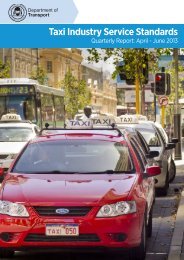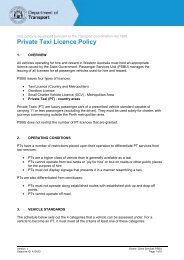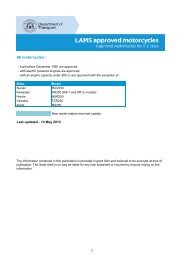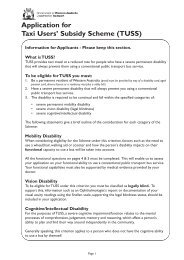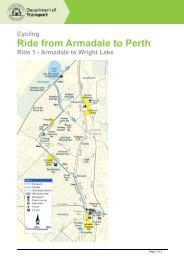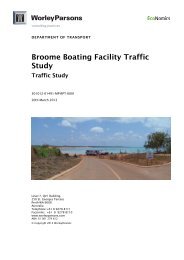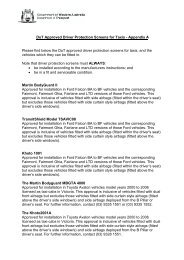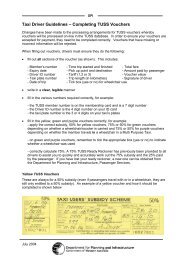Department of Transport Annual Report 2010 - 2011
Department of Transport Annual Report 2010 - 2011
Department of Transport Annual Report 2010 - 2011
Create successful ePaper yourself
Turn your PDF publications into a flip-book with our unique Google optimized e-Paper software.
<strong>Department</strong>al desired outcome 1: An accessible and safe transport system<br />
DoT’s responsibility for the accessibility and safety <strong>of</strong> the transport system derives<br />
from the <strong>Transport</strong> Co-ordination Act 1966 (the Act). The Act confers on DoT the<br />
responsibility for co-ordinating and planning the transport system and enabling<br />
accessibility and safety considerations.<br />
There are varying degrees <strong>of</strong> accessibility and safety across the agency for the<br />
different modes <strong>of</strong> transport. For example, Marine Safety provides regulation,<br />
education, training and compliance monitoring in regards to safety <strong>of</strong> marine<br />
vessels, whereas accessibility to marine related infrastructure and waterways is the<br />
responsibility <strong>of</strong> Coastal Infrastructure.<br />
Rail safety is managed by the Office <strong>of</strong> Rail Safety, which is charged with<br />
administering the Rail Safety Act <strong>2010</strong> in Western Australia and nationally as part <strong>of</strong><br />
a national approach to rail safety regulation. It does this by ensuring railway owners<br />
and operators comply with regulatory standards to construct, operate and maintain<br />
railways. Accessibility to railways is the responsibility <strong>of</strong> the owners and operators.<br />
Accessibility to taxis is the responsibility <strong>of</strong> the Passenger Services whereby they<br />
are responsible for ensuring an adequate taxi service is being provided to the<br />
public <strong>of</strong> Western Australia. Safety in taxis in regards to vehicles and drivers is the<br />
responsibility <strong>of</strong> DVS in its role in administering the Road Traffic Act 1974 and is<br />
covered under Outcome 2 <strong>of</strong> the DoT’s outcome structure: “Vehicles and road users<br />
that meet established vehicle standards and driver competencies”. Safety for taxi<br />
operators and passengers not related to use on the road is the responsibility <strong>of</strong> the<br />
Western Australia Police in its community safety role.<br />
Accessibility to regular public transport air services is the responsibility <strong>of</strong> the<br />
<strong>Transport</strong> Policy and Systems, which ensures adequate air services are provided to<br />
key regional communities throughout the State. Aviation safety is controlled through<br />
the Commonwealth Government’s Civil Aviation Safety Authority. DoT ensures all<br />
aircraft that carry passengers for regular public transport or charter purposes within<br />
Western Australia are licensed annually.<br />
Effectiveness key performance indicators<br />
Percentage <strong>of</strong> standard metropolitan (non multi-purpose) taxi jobs not covered<br />
The Taxi Act 1994 bestows on DoT, through Passenger Services, the responsibility<br />
<strong>of</strong> regulating Perth’s metropolitan taxi industry.<br />
Following the 1999 National Competition Policy Review <strong>of</strong> the industry, the then DPI<br />
introduced industry performance standards. The standards have been in place<br />
since 1 July 2000 to ensure that the public receives acceptable levels <strong>of</strong> service and<br />
the taxi industry is required to meet these performance standards. An independent<br />
external consultant analyses taxi industry data, sourced from the taxi dispatch<br />
service (TDS) providers, and reports on taxi demand and industry viability trends<br />
as well as the performance <strong>of</strong> the taxi industry against the industry standards on a<br />
monthly and quarterly basis.<br />
This assessment gives DoT the ability to provide the Minister with evidence-based<br />
policy recommendations and therefore directly assists the regulatory function <strong>of</strong> the<br />
DoT.<br />
The key performance indicator <strong>of</strong> taxi service is jobs not covered (JNC), which is the<br />
percentage <strong>of</strong> total jobs going unserviced in the peak and <strong>of</strong>f-peak periods.<br />
Trends from this indicator assist with determining supply and demand requirements<br />
for the industry and provide rationale for determining whether or not there is a<br />
requirement to release additional taxi plates.<br />
Industry performance is assessed by obtaining and analysing data from the two<br />
major TDS providers in the metropolitan area. Of these, the number <strong>of</strong> customer<br />
telephone orders placed on and advertised through the taxi company dispatch<br />
system and the number <strong>of</strong> jobs not covered against these orders are recorded.<br />
Percentage<br />
<strong>of</strong> standard<br />
metropolitan<br />
(non multipurpose)<br />
taxi<br />
jobs that were<br />
not covered.<br />
2007-08<br />
actual<br />
2008-09<br />
actual<br />
2009-10<br />
actual<br />
<strong>2010</strong>-11<br />
target<br />
<strong>2010</strong>-11<br />
actual<br />
3.60% 1.79% 1.18% 1.00% 1.60%<br />
Reasons for significant variance<br />
During the <strong>2010</strong>-11 year, the<br />
demand for metropolitan taxis has<br />
increased by 9.4 per cent (peak<br />
and <strong>of</strong>f-peak period demand<br />
combined). As a consequence<br />
<strong>of</strong> this increase in demand, the<br />
percentage <strong>of</strong> jobs not covered<br />
has also increased.<br />
95



